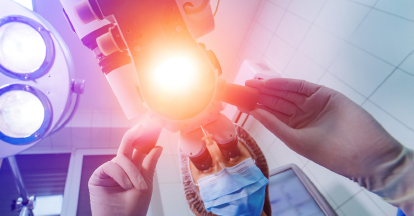Cataract, Refractive
Rescuing Eyes from Refractive Disasters
Innovative solutions necessary to salvage vision in eyes with severe complications from corneal refractive surgery.

Roibeard O’hEineachain
Published: Saturday, April 1, 2023
Roibeárd O’Héineacháin Reports
When corneal refractive surgery goes wrong, the results can be devastating, but often remedies exist that can optimise outcomes. To illustrate the possible complications and the means to resolve them, Dr A John Kanellopoulos described a few cases referred to him over the years, and his treatment strategies.
The first case involved a 62-year-old physician who had undergone femtosecond laser-assisted cataract surgery but experienced irregular astigmatism in his right eye as a result of eccentrically placed astigmatic keratotomies. One of the incisions crossed the visual axis, causing a significant corneal irregularity. Dr Kanellopoulos treated the patient with a topographically guided LASIK procedure. Afterwards, the patient’s eye had an uncorrected visual acuity of 20/15, and with bifocal spectacles, near visual acuity of 20/20.
The second case was much more complex. It concerned a woman who underwent an unsuccessful small lenticule extraction (SMILE) procedure. Due to three incomplete passes with the femtosecond laser, the surgeon converted to refractive lenticule extraction (RELEX) with manual removal of the lenticule. The patient started with a refractive error of around -6.0 D but postoperatively had a sphere of -10.0 D and a cylinder of -2.5 D at 160 degrees in her right eye and a sphere of -8.25 D and a cylinder of -4.5 D at 160 degrees in her left eye with best corrected visual acuities of 20/100 and 20/200, respectively.
Athens Protocol
After carefully reviewing the topographic imaging, OCT pachymetry, and corneal epithelial mapping, Dr Kanellopoulos offered the patient the option of undergoing the Athens Protocol treatment. The four-step procedure occurs in a specific order: First, a topographically guided, minimal tissue removal, photorefractive keratectomy (PRK), followed by a phototherapeutic keratectomy (PTK), the application mitomycin-C 0.2% for 30 seconds, and lastly corneal cross-linking (CXL) for 15 seconds with a fluence of 6 mW/cm2. The patient also underwent a minor PRK enhancement six months later, finally achieving an uncorrected visual acuity of 20/40 and a corrected visual acuity of 20/30.
“Although not an ectasia case, in view of a normalising the corneal surface and stabilising the very thin cornea, we used the Athens Protocol with a PRK enhancement resulting in a drastic improvement in visual acuity,” Dr Kanellopoulos observed. “This is just a reminder that the Athens Protocol is a very frugal, in-tissue removal, therapeutic approach to treat irregular corneas.”
Another patient whose vision he helped improve with the protocol was a 26-year-old helicopter pilot from New York City grounded after developing post-LASIK ectasia. In this case, the treatment not only restored corneal surface regularity but improved his vision from 20/60 to 20/15. The patient has since enlisted in the US Air Force and serves as a fighter pilot.
The last example was a patient who developed a corneal melt after undergoing hyperopic LASIK and implantation of a Teardrop (ReVision Optics) corneal inlay in the non-dominant eye. The patient was an “avid” eye rubber and returned to Dr Kanellopoulos with a melt in the inlay area with significant inflammation and corneal irregularity. Corrected visual acuity was 20/80. After removing the inlay, he chose the non-surgical option of long-term treatment with steroid and cyclosporine eyedrops to manage the severe central scar and corneal divide.
Three months of treatment later, the patient’s eye improved to UDVA 20/100 and corrected visual acuity of 20/40 with a refraction of +6.0 D and -0.5 D at 76 degrees. Five years postoperatively, the scar had subsided significantly, and uncorrected and corrected visual acuity had improved to 20/30 and 20/25, respectively, and refraction had improved to +1.75 D and -0.75 D at 125 degrees. With these outcomes, the patient discontinued treatment, and at nine years, the patient’s cornea had a near normal curvature and corrected and uncorrected visual acuity improved to 20/20.
“In this case, the cornea’s stromal and epithelial natural remodelling was able to diminish the irregularity with the help of topical medication without surgical intervention, apart from removing the inlay,” he noted.
Dr Kanellopoulos presented his findings at the 40th Congress of the ESCRS in Milan.
A John Kanellopoulos MD is the Director, Laservision Eye Institute, Athens, Greece, and Clinical Professor, Department of Ophthalmology, NYU School of Medicine, New York, US. ajk@laservision.gr
